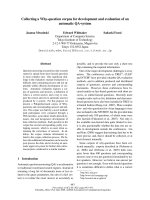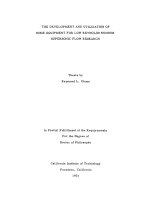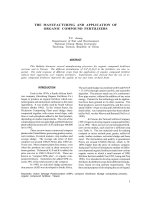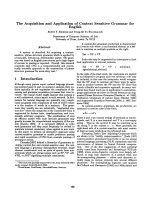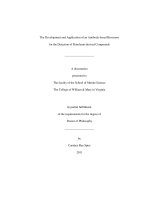the development and application of an antibody based biosensor
Bạn đang xem bản rút gọn của tài liệu. Xem và tải ngay bản đầy đủ của tài liệu tại đây (1.9 MB, 163 trang )
The Development and Application of an Antibody-based Biosensor
for the Detection of Petroleum-derived Compounds
____________________
A dissertation
presented to
The faculty of the School of Marine Science
The College of William & Mary in Virginia
In partial fulfillment
of the requirements for the degree of
Doctor of Philosophy
____________________
by
Candace Rae Spier
2011
APPROVAL PAGE
This dissertation is submitted in partial fulfillment of
the requirements for the degree of
Doctor of Philosophy
_________________________
Candace Rae Spier
Approved by the Committee, May 2011
________________________________________
Stephen L. Kaattari, Ph.D.
Committee Co-Chairman/Advisor
________________________________________
Michael A. Unger, Ph.D.
Committee Co-Chairman/Advisor
________________________________________
John M. Brubaker, Ph.D.
________________________________________
Erin S. Bromage, Ph.D.
University of Massachusetts-Dartmouth
Dartmouth, MA
________________________________________
Thomas M. Harris, Ph.D.
Vanderbilt University
Nashville, TN
iii
DEDICATION
In loving memory of Zedia Mae Fludd, may she never be forgotten.
iv
TABLE OF CONTENTS
Page
ACKNOWLEDGEMENTS vii
LIST OF TABLES viii
LIST OF FIGURES ix
ABSTRACT xi
INTRODUCTION 2
Petroleum 2
Petroleum as a pollutant 2
Petroleum composition, characteristics, and fate 2
Toxicity from the WAF of petroleum 5
Current technologies for measuring PAHs 7
Classical analytical chemistry: laboratory-based methods 7
Analytical on-site PAH assessment tools 8
Overview of immunoassays 9
Commercially available immunoassays for PAHs 13
Overview of biosensors 14
Development of antibodies to small molecules 18
Antibody recognition characteristics 18
Affinity maturation and antigen binding site diversity 20
Immunizations and mAb production 21
Hapten production and protein conjugation 25
Sapidyne’s KinExA Inline sensor 27
Benefits of environmental assessment of PAHs 27
RATIONALE AND OBJECTIVES 30
MATERIALS AND METHODS 31
Hapten synthesis and validation 31
Other haptens employed 36
Antigen and immunogen preparation 36
Hapten activation 36
Protein conjugation 36
Animals and immunization routines 38
Monoclonal antibody production 39
Magnetic bead isolation 40
Antibody characterization 40
ELISA plate preparation 40
Titration screening assays 40
Checkerboard assay 42
Competitive inhibition assays (cELISAs) 42
v
Biosensor development 45
Calibration curves for the biosensor 46
Matrix effects 46
Biosensor environmental applications 47
Site description and sample collection 47
Groundwater monitoring 47
Estuarine monitoring 48
Toxicological study 49
Stormwater runoff study 49
Analytical analysis of PAHs 49
Biosensor analysis of PAHs 51
Statistical analyses 51
RESULTS 52
Validation of synthesized haptens 52
Hapten to BSA conjugation 68
Hapten to OVA conjugation 68
Serum antibody titration 68
Sera inhibition screenings 71
MAb production 82
MAb titration 85
MAb inhibition screening 85
Biosensor development 88
Antibody kinetic analysis 88
Calibration curves for the biosensor 88
Solvent effects 92
Salinity effects 92
DOC effects 95
Biosensor applications 95
Groundwater monitoring 95
Estuarine monitoring 98
Toxicological study 98
Stormwater runoff study 101
DISCUSSION 106
Haptenation efficiency with hydrophobic haptens 106
Generation of amines from DMF solvent 108
Thiomersal interference 108
Antisera specificities 108
Employing cELISA during mAb development 112
Magnetic bead isolation comments 113
Sensitivity and specificity of 7B2.3 compared to other anti PAH antibodies 113
Immunoassay performance compared to commercially available technology 114
Biosensor performance compared to the literature 115
Future Perspectives 120
vi
APPENDICES 121
A. Summary of anti-PAH antibodies presently in the scientific literature 121
Review of PAH Biosensors 121
Electrochemical Detection 121
Capacitance 125
Amperometric transducers 126
Piezoelectric transducers 128
Optical 129
Surface Plasmon Resonance 129
Fluorescence-based detection 130
Natural PAH fluorescence 131
Polarized fluorescence 131
Fluorescence intensity from a label 132
Reflectometric interference UV/VIS spectroscopy 133
Infrared 133
Current state of PAH biosensor technology 134
Comparisons of biosensor and classical analytical methods 134
Antibody incubation times 135
Comparison of label-free and labeled reagents 135
Reusability of biosensors 137
Applications to other areas of health and disease 137
B. Inline biosensor sample handling protocols 138
LITERATURE CITED 140
VITA 152
vii
ACKNOWLEDGEMENTS
First and foremost, I am extremely grateful for having, not one, but two great and equally
dedicated advisors, Dr. Stephen Kaattari and Dr. Michael Unger. Their mentorship,
patience, and enthusiasm for science are values I will forever cherish and strive to uphold
in my future endeavors. I am delighted that I could learn under their expert tuteledge,
and to put forth this fun and innovative multidisciplinary project. They both have
changed me professionally and personally in more ways than they possibly even realize.
In addition to my advisors, this work would not have been conceived of nor conducted
without Dr. Erin Bromage and Dr. Tom Harris. I am very appreciative of their
willingness to teach and their endles intellectual support. I am thankful to Dr. John
Brubaker, who graciously accepted the task of serving on my committee and for allowing
me to teach him immunology and chemistry.
I am extremely indebted to those who have helped me in this project. Thanks specifically
to George Vadas for always being available for advice and, even more so, assistance. I
am forever grateful for the many times that George went above and beyond to provide me
help in acquiring and interpreting the data. Endless thanks to Mary Ann Vogelbein for
helping me keep cell cultures alive day in and day out, keeping a positive attitude even
when things were not working, and for being an overall joy to work with. Many thanks
to Ellen Harvey for her extreme patience and exceptional skill in analyzing synthetic
products that may or may not exist. I would have drowned in a sea of glassware, had it
not been for the extraordinary efforts of Ellen Travelstead. This project certainly would
not have been as successful without the hardware and software aid of Terrance Lackie
and Mike van Orden from Sapidyne.
I would also like to thank all those who I have worked with over the years in Dr.
Kaattari’s lab. Namely, Ilsa Kaattari, Dr. Jianmin Ye, and Colin Felts, whose help,
friendship, and support have been invaluable. I especially wish to thank those numerous
friends who doubled as colleagues in helping me to collect samples, find resources, or
examine statistical methods. I owe a special debt of gratitude to the mice.
This work would not have have been possible without the financial support from ONR,
NOAA CICEET, NSF’s GK-12 PERFECT Program, W&M Student Activities
Conference Funds, SETAC conference awards, SMS Dean Equipment grant, SMS
Student Research Grant, GSA mini-grant, and Hawai’i Institute of Marine Biology’s
Pauley Summer Program. I equally wish to broadly acknowledge the immense technical
support at VIMS.
Finally, I am forever grateful for the cheerful company of my friends, both in Virginia
and afar, who I wish not to list for fear that I will inadvertently omit someone. Last, and
certainly not least, I thank my family (parents Ronald and Janet; siblings Bret, Jesse and
Brianna; in-laws Ellee and Erin; nephew/nieces Austin, Orlee, and Madison) for their
everlasting love, enthusiasm for science, and encouragement to pursue whatever it is I
want to do.
viii
LIST OF TABLES
Table Page
1 Comparison of traditional and immunoassay techniques 11
2 Illustration of structural similarities of derivatized haptens and target analytes. 43
3 NMR assignments for synthesized compounds 54-55
4 Conjugation ratios of the DBTAA-BSA conjugates 69
5 Hapten and carrier protein titers of experimental mice. 72
6 Summary of antibodies to PAHs 122
7 Features and specifications of PAH immunosensors 123
8 The types of transducers used in PAH biosensors 124
ix
LIST OF FIGURES
Figure Page
1 Structures and names of selected PAHs 4
2 The thiophenes targeted for antibody development 6
3 Illustration of a cELISA 12
4 Structures of compounds showing cross-reactivity 15
5 Schematic of a generalized biosensor 16
6 A schematic of a classical monomeric antibody molecule 22
7 Antibody recognition diversity of the immune response 23
8 Examples of a target PAH analyte/hapten and conjugate 26
9 KinExA Inline sensor 28
10 Structures of all haptens used throughout this investigation 32
11 Synthesis and mass spectrum of DBTAA 53
12 Synthesis and mass spectrum of BT5AA 56
13 Synthesis and mass spectrum of 2TAA 58
14 Synthesis and mass spectrum of 3TAA 59
15 Synthesis and mass spectrum of 5M2TAA. 60
16 Synthesis and mass spectrum of 2MF9AA 61
17 Synthesis and mass spectrum of 3MF9AA 62
18 Mass spectrum of the dimethylamine of 3MF9AA 64
19 Mass spectrum of the methyl ester of 3MF9AA 65
20 Mass spectrum of 2BIPAA 66
21 Mass spectrum of 4BIPAA 67
22 A representative serum titration over the course of immunization. 70
23 Titration ELISA of BT3AA-KLH sera 73
24 Competitive ELISA of 3TAA-KLH sera 74
25 Competitive ELISA of DBTAA-KLH sera 76
26 Competitive ELISA of 2MF9AA-KLH sera 77
27 Competitive ELISA of 4BIPAA-KLH and 2BIPAA-KLH sera 78
28 Competitive ELISA of 4BIPAA sera generated to various protein carriers 79
29 Competitive ELISA of 4BIPAA-KLH sera (4
th
) 80
30 Competitive ELISA of 4BIPAA-KLH sera (3
rd
) 81
31 Competitive ELISA of 2MF9AA-KLH sera 83
32 Competitive ELISA of BT3AA-KLH sera 84
33 Titer of 7B2.3 using antigen DBTAA-BSA 86
34 Competitive ELISA of 7B2.3 against unsubstituted PAHs 87
35 Competitive ELISA of 7B2.3 against alkylated PAHs 89
36 Competitive ELISA of 7B2.3 against other environmental contaminants 90
37 Biosensor calibration curves 91
38 Solvent interactions on antibody binding 93
39 Salinity interactions on the biosensor 94
40 Humic acid interactions on the biosensor 96
x
41 Comparison of PAH concentrations during the groundwater monitoring 97
42 Near real-time PAH monitoring of the remedial dredging project 99
43 Comparison of PAH concentrations during the estuarine monitoring 100
44 Comparison of phenanthrene concentrations during the toxicology study 102
45 Biosensor detection of 1-hydroxyphenanthrene 103
46 Near real-time monitoring of PAH concentrations in stormwater runoff 104
47 Comparison of PAH concentrations from the stormwater runoff study 105
48 Spatial illustrations of biphenyl, 4BIPAA, and 2BIPAA 110
49 Label-free detection methods 136
xi
ABSTRACT
Petroleum is one of the most important natural resources, but can also be problematic to
environmental and human health. Petroleum is comprised of thousands of compounds,
including polycyclic aromatic hydrocarbons (PAHs) and heterocycles, some of which are
toxic and/or carcinogenic. Traditional analytical methods for environmental monitoring
of low-level PAHs are time-consuming, labor-intensive, and often laboratory-bound.
Efforts to achieve timely, sensitive, and accurate analysis of PAHs in the field have
become a priority for environmental research and monitoring. Antibody-based
biosensors are presently being developed for environmental analysis. Anti-PAH antibody
molecules can be coupled with electronic transducers to provide new biosensor
technology for the rapid determination and quantification of PAHs. Although PAHs are
not immunogenic on their own, advances in immunology have provided the means to
develop antibodies to PAHs.
Thiophenes, a defined subset of aromatic heterocycles, were selected as the target
molecules for antibody development. Characterization of a monoclonal antibody (mAb)
to dibenzothiophene revealed specificity for 3 to 5-ring PAHs and heterocycles.
Therefore, the goals of antibody development were focused on developing additional
antibodies to 2-ring PAHs and to alkylated PAHs. Characterization of antibodies to these
novel targets revealed unexpected insights into antibody induction and specificity;
namely suitable hapten sizes for small hydrophobic molecule recognition should be larger
than one benzene ring, derivatization of the hapten target in immunogen synthesis must
preserve structural characteristics, the utility of heterologous assay formats can improve
antibody inhibition, and high antibody titers can result in limited assay sensitivity.
The anti-dibenzothiophene mAb 7B2.3 was employed, along with a fluorescence-based
transducer, for the generation of a new biosensor for PAHs. The biosensor was utilized
in a variety of different applications to determine dissolved PAH concentrations
including: 1) sampling groundwater at a former wood-treatment (creosote) facility, 2)
analyzing estuarine water during the dredging of PAH-contaminated sediments, revealing
a plume of PAHs emanating from the dredge site, 3) frequent monitoring of phenanthrene
(a 3-ring PAH) concentrations during a laboratory toxicological dosing study, and 4)
monitoring PAH concentrations in stormwater runoff into both a retention pond and a
river near a roadway.
Overall, these applications demonstrated the utility of this biosensor for rapid analysis of
PAHs in a variety of aqueous environments. The biosensor was operated on-site for both
the estuarine and groundwater monitoring trials. The biosensor could process samples,
produce quantitative measurements, and regenerate itself in approximately 10 minutes.
Sample volumes of 400 µl could be used with little to no sample pretreatment. Most
importantly, PAHs could be quantified down to 0.3 µg/l in the field using the sensor
platform. These results were validated with conventional gas chromatography-mass
spectrometry and high performance liquid chromatography analytical methods. This
system shows great promise as a field instrument for the rapid monitoring of PAH
pollution.
1
The Development and Application of an Antibody-based Biosensor
for the Detection of Petroleum-derived Compounds
2
INTRODUCTION
Petroleum
Petroleum as a pollutant
Petroleum is one of the most important natural resources. It is extensively used for fuel,
plastics, fertilizers, and artificial fibers in clothing, in addition to other common products.
However, it becomes problematic when it enters the environment resulting in deleterious
effects on ecosystem and human health. Although some of the petroleum that enters the
aquatic environment is from natural seepages, the more detrimental inputs are from
extraction, transportation, and consumption of petroleum (NRC 2003). These petroleum
inputs include, but are not limited to, land-based runoff, recreational vessel discharge,
operational discharges, spills, pipeline leaks, atmospheric deposition, and aircraft
dumping (NRC 2003). The potential for accidental release into the aquatic environment
is magnified in areas where transportation, storage, or use is centered near waterways. If
and when spills occur, there is a need for immediate and sensitive water quality
assessments to better understand the potential harm to sensitive aquatic habitats.
Petroleum composition, characteristics, and fate
Petroleum is formed from the ancient remains of marine plant and animal life under
extreme heat and pressure in an anaerobic environment. Depending on the composition
of the organic material, varying proportions of aliphatic or aromatic hydrocarbons will be
formed. The third most abundant element in petroleum is sulfur, which can account for
0.05 to 13.9% of the total weight depending upon the source of the petroleum (Kropp and
Fedorak 1998).
3
The polycyclic aromatic hydrocarbons (PAHs) can be divided into two groups based on
their physical and chemical characteristics. For my purposes, the low molecular weight
PAHs include the 2- to 3-ring structures while the high molecular weight PAHs are those
with 4- to 5-rings (Figure 1). Generally speaking, as the molecular weight increases,
PAH aqueous solubility decreases, as does their susceptibility to vaporization (Neff
1979). Furthermore, alkyl substitutions on the aromatic ring results in an overall
decrease in PAH solubility. Solubility is enhanced three- to four-fold by a rise in
temperatures from 5 to 30°C, and by dissolved and colloidal organic fractions which
incorporate PAHs into micelles (Neff 1979). Vapor pressure characteristics influence the
persistence of PAHs in the aquatic environment, with low molecular weight PAHs being
more volatile and high molecular weight PAHs demonstrating insignificant
volatilizational loss under all environmental conditions (Moore and Ramamoorthy 1984).
As a result of these varying characteristics, PAHs will differ in their behavior,
distribution, and biological effects.
Although PAHs are hydrophobic, they are slightly soluble in water, and those that are
soluble in water are therefore termed the water-accommodated fraction (WAF). In fact,
the aquatic ecosystem is one of the major sinks of PAH contamination (Tao et al. 2003).
Due to their hydrophobic nature, PAHs entering the aquatic environment exhibit a high
affinity for suspended particulates in the water column and will tend to sorb to these
particles (Kayal and Connell 1990, Shi et al. 2007). Because of this partitioning with the
sediments, the PAH concentrations in water are usually quite low relative to bottom
sediments (Moore and Ramamoorthy 1984). Moreover, because of their hydrophobic
nature and high lipophilicity PAHs are known to bioaccumulate in aquatic organisms
(Meador et al. 1995). The overall fate of a PAH fraction will highly depend on the
temperature, turbulence, depth, and pollution status of the water (NRC 2003). As a
result, loss/degradation of a PAH will vary both in time and space.
4
Figure 1. Structures and names of selected PAHs.
5
Toxicity from the WAF of petroleum
Despite the lower concentrations in the WAF, it is this bioavailable fraction that is
responsible for the aquatic toxicity associated with petroleum (Byrne and Calder 1977,
Nicol et al. 1977, Millemann et al. 1984, Neff et al. 2000, Mori et al. 2002, Neff et al.
2005, Rhodes et al. 2005). The low molecular weight PAHs demonstrate significant
toxicity, whereas the high molecular weight PAHs are less toxic, but are carcinogenic.
As a general trend, toxicity increases as a PAH gains alkyl groups (Neff et al. 2005).
Acute toxicity has been seen in a range of species of fish and other aquatic organisms at
concentrations much less than 1 ppm (mg/l). The alkylated PAHs found in petroleum are
relatively more abundant, tend to persist longer (i.e., do not volatilize, biodegrade, or
photooxidize as readily) and bioaccumulate to a greater degree than the non-alkylated
compounds (Sauer and Uhler 1994). Moreover, Barron and colleagues (1999) postulate
that perhaps it is not only the PAHs, but also the heterocycles (PAH analogs containing
sulfur, nitrogen or oxygen) that contribute to the toxicity of the WAF. Similarly,
heterocycles are expected to follow the same trends as PAHs with regard to increased
toxicity with increased alkylation and a tendency to bioaccumulate and persist. Within
the subclass of heterocycles, sulfur-containing analogs, although less studied than PAHs,
are the next most abundant compounds and are predominantly arylthiophenes
(benzothiophene, dibenzothiophene, naphthobenzothiophene) and their alkyl derivatives.
Seymour and coworkers (1997) showed that many of the condensed thiophenes were
more soluble than the similarly sized PAHs. Research on the fate of thiophenes suggests
that they persist longer than PAHs in aquatic systems (Kropp and Fedorak 1998).
Therefore the toxicity, solubility and persistence of polycyclic aromatic heterocycles,
especially thiophenes, make them excellent targets when monitoring for petroleum
(Figure 2).
6
Figure 2. The thiophenes targeted for antibody development. These compounds are
found in petroleum, in the WAF of petroleum, and demonstrate some acute toxicity.
7
Current technologies for measuring PAHs
Classical analytical chemistry: laboratory-based methods
There are several analytical methods available for detecting and measuring PAHs in
water, sediment, air and biological samples. The earliest and simplest technique is a
gravimetric analysis in which a sample is extracted using a non-polar organic solvent
(Stenstrom et al. 1986). The extracted fraction is then evaporated and the residue is
weighed on a balance. Although this remains a cheap and readily available option for
quantifying total extracted organics, very large samples must be used for low level
analysis. In addition, the low molecular weight molecules are commonly lost to
volatilization and the high molecular weight compounds are often not recovered well in
liquid/liquid extractions (Stenstrom et al. 1986). Furthermore, there is a high risk of
extracting naturally-derived compounds, or unrelated compounds, with a similar
solubility to the PAHs, which makes it inaccurate as a petroleum measuring tool.
PAHs exhibit high absorptivities of UV radiation. Likewise, they exhibit strong
fluorescence emission patterns that are specific to aromatic structures (Lee et al. 1981).
Beyond quantification, these techniques allow for differentiation among aromatic
structures. The disadvantage of these tools is the interference from other similar
molecules. However, by acquiring proper standards and known material, these
interferences can be accounted for. The more common and acceptable practice is the
combination of some form of chromatographic separatory preparation prior to employing
these technologies for detection.
Most well-established analytical methods employ gas chromatography (GC, equipped
with a mass spectrometer (MS) or flame ionization detector) or high-performance liquid
chromatography (HPLC, coupled with an UV detector or a fluorescence detector) (Poster
et al. 2006). GC separates complex PAH mixtures via differential partitioning between a
mobile gas phase and a stationary liquid phase. The polarity-based affinity of the column
for the compounds permits the differential elution of the PAH compounds whereupon a
8
MS can be employed to speciate the compounds. Employing a similar principle, HPLC
pumps a mobile liquid phase at high pressure through a column. Compounds are eluted
from the column and are detected by UV or fluorescence.
Federal agencies such as the United States Environmental Protection Agency (US EPA)
and National Institute for Occupational Safety and Health routinely use GC-MS and
HPLC methods in their protocols for environmental sample analysis (e.g., Methods 8270
and 8310). A complication to this analysis is that environmental samples involve a
variety of media (aqueous, solids, sludges, biological samples, or a combination of these).
Under such conditions, these methods will be compromised by interfering compounds
having PAH-like physical characteristics, however much of this has been eliminated by
the use of standards and with the sensitivity of the detection devices (i.e., MS). Thus
although these methods may be standard for laboratory analyses of environmental
samples, they suffer considerably as an option for more routine monitoring, as the
approaches are expensive, labor-intensive, and time-consuming.
Analytical on-site PAH assessment tools
Efforts to improve on the laboratory-bound methodologies have become a priority for
environmental research and monitoring (Rogers 1995, Płaza et al. 2000, Rodriguez-
Mozaz et al. 2006). The goal of developing new on-site assessment technologies is to
reduce the expertise, time, and equipment needed, as well as offering comparable or
improved measurements. Other requirements for on-site technologies are to minimize the
power requirements and to reduce dangerous waste materials (toxic reagents, halogenated
solvents, etc.), produced. Although not all of these characteristics can be obtained with a
single tool, the goal is to maximize performance with a minimized input.
For the analysis of PAHs in motor oil in soil, a thin-layer chromatography (TLC) field
method has been developed as a screening tool (Newborn and Preston 1991). Following
separation by TLC, iodine staining and UV exposure were employed for visualization of
UV active material. Although it only has a detection limit of 100 ppm (ppb detection
9
often required), it is a cost-effective tool for preliminary assessments compared to
bringing every sample back to the laboratory for conventional analysis.
The first field portable GC-MS has demonstrated environmental analysis capabilities.
The Viking SpectraTrak
TM
672 GC-MS has been verified by the Environmental
Technology Verification Program created by the US EPA and determined to provide
detection limits of about 5 ppm for volatile and semi-volatile organic contaminants
(which includes PAH detection) in air samples, and 5 ppb (µg/l) for soil and liquid
samples (1997). The system cost and training starts around $150,000, requires a power
source during field operation, and the columns are more susceptible to breaking because
they must be wound around a smaller cage than normally required in the lab (US EPA
1997). On-scene arson crime investigations made use of these portable GC-MS devices
when testing for petroleum-based accelerants in the case of arson (Pert et al. 2006).
Though they are not concerned with quantification, the use of GC allows the ability to
distinguish between the pyrogenic and petrogenic PAHs.
This ultimately leads to the most recently employed ICx Griffin 400 field portable GC-
MS instrument, equipped with a helium gas tank, by the Army Corps of Engineers
(Bednar et al. 2009). Solvent extractions of both sediment and water samples collected
from the dredging of a PAH-contaminated area were conducted in the field. In addition
to the time it took for sample preparation, sample analysis required 21 minutes. The
instrument possessed a field method detection limit of 20 ppb (µg/l); however none of the
samples assessed in this study were quantifiable in the field, because they were lower
than the field method detection limit. The laboratory results confirmed this assessment,
whereby the authors suggest that this field method produced no false positives or
negatives. Nonetheless, all of these field-based methods still lack speed, ease of use, and
sensitivity.
Overview of immunoassays
Presently, immunoassays are being developed as tools for environmental monitoring. An
10
immunoassay is a chemical test based on the use of antibodies, which exhibit molecular
specificity and high affinity binding characteristics for a particular target or antigen.
Immunoassays allow selective recognition even in complex matrices, due to their
selective antibody/antigen interaction. Other factors rendering immunoassays as
desirable tools for environmental analysis are their reliability, low cost, speed of analysis,
ease of use, portability, and sensitivity (Van Emon and Gerlach 1998). Immunoassays
can be faster and cheaper to manufacture and use than traditional techniques, as shown in
Table 1 composed by Płaza et al. (2000).
The sensitivity of immunoanalysis is reliant on the antibody’s affinity. As noted by Van
Emon and Gerlach (1998), immunoassays have a tendency to report higher analyte
concentrations when compared to GC-MS or HPLC. They further suggest that this is the
result of the need for fewer procedural steps, resulting in higher analyte recoveries or
because of antibody cross-reactivity with similarly structured molecules or derivatives.
The most commonly employed immunochemical assay is the Enzyme-Linked
ImmunoSorbent Assay (ELISA), which was first described in 1972 by Eva Engvall and
Peter Perlman. Though the name suggests it uses enzymes, the actual recognition
molecule is an antibody, while the enzyme portion is coupled to the antibody to elicit a
colorimetric signal. An ELISA is a technique that allows for the determination of
antibodies in a sample. In short, the antigen (analyte) specific to the enzyme-linked
antibody is immobilized onto a surface. This surface is then exposed to the sample
allowing antibodies to bind to the antigen-coated surface. After the surface is washed, it
is immersed in a chromogenic substrate solution resulting in an enzyme-catalyzed
reaction of the substrate producing a colorimetric change in direct proportion to bound
antibody. The amount of antibody bound to the antigen is determined from the initial rate
of reaction, which is proportional to the quantity of enzyme captured.
In this research, for the most part, a ‘competitive inhibition ELISA (cELISA)’ is
performed (Figure 3). An antigen specific to the enzyme-linked antibody is immobilized
on a surface. This surface is then exposed to the sample in combination with the enzyme-
linked antibodies. If an analyte is present in the sample it will compete with the
11
Table 1. Comparison of traditional and immunoassay techniques for environmental
sampling. Taken from Płaza et al. (2000).
12
Figure 3. An illustration of an antibody assay demonstrating competitive inhibition by
underivatized PAHs in a sample. The resulting signal is inversely proportional to the
PAH concentration. (Antibodies are illustrated as Y-shaped structures.)
13
immobilized antigen, leaving less antibody molecules available to bind the immobilized
antigen. During chromogenic development, the rate of reaction, which is proportional to
the quantity of enzyme captured, is inversely proportional to the quantity of soluble
antigen (e.g., PAH) in the sample. Examples of commercially available immunoassay
test kits are home pregnancy tests, HIV tests, and a few environmental monitoring kits for
PAHs. Although PAH-specific immunoassays already exist, it is the goal of this project
to improve upon the sensitivity of such systems and to link the antibodies with
instrumentation to make them available as a monitoring tool.
Commercially available immunoassays for PAHs
Commercially available PAH immunoassays are available through SDIX, Abcam, ExBio,
Novus Biologicals, Santa Cruz Biotechnology and Quantix Systems. Although they are
not all explicitly for water analysis, some valuable information can be gleaned from their
use, as well as, how their assay systems are designed. For instance, the Quantix Systems
assay is a disposable plastic analyte detector that has been used on wildlife exposed to oil
in seawater (Mazet et al. 1997). The target antigen (PAH) is conjugated to an enzyme,
while the anti-PAH antibody was immobilized. This allows for a competitive assay, in
which the underivatized PAH in the extracted sample can compete with the PAH-enzyme
to bind the immobilized antibody. The unbound PAH-enzymes will be washed away.
Subsequently, the chromogenic substrate is introduced and the colored product is
quantified using a hand-held refractometer. As the PAH concentration in the sample
increases, the color endpoint decreases in intensity.
SDIX has offered a variety of field-deployable immunoassays. For the PAH
immunoassay, samples require extraction of the PAH analytes into an aqueous phase
before analysis. Chuang et al. (2003) compared the SDIX immunoassay with GC-MS
concluding that the ELISA measurements are highly correlative and thus is a suitable
broad screening tool for environmental PAH monitoring. Explicitly, the ELISA often
provided higher estimates than the GC-MS, which the authors expected because of the
14
ability of the antibody to cross-react with a number of other PAHs not included in the 19
targeted by the GC-MS method.
In the published literature on PAH immunoassays, typically ELISA kits use one antibody
to determine the overall PAH concentration. The concentration is reported as a single
compound, frequently benzo[a]pyrene. More precisely, the result is reported as
benzo[a]pyrene equivalents. One goal of this study was to develop antibodies to different
petroleum targets, lower versus higher molecular weight polycyclic aromatic
heterocycles. The majority, if not all of the current PAH immunoassays possess a fair
amount of cross-reactivity. For example, Nording and Haglund (2003) evaluated the
cross-reactivity of a commercially available antibody induced by phenanthrene. Cross-
reactivity with fluorene was 140% while compounds with a sulfur, nitrogen, oxygen, or
carbonyl group at the nine position of a fluorene molecule showed cross-reactivity values
of 28, 8, 7, and 6%, respectively (Figure 4). They concluded that replacing carbon-7 with
other atoms had an influence on the cross-reactivity.
Overview of biosensors
A biosensor is simply a hybrid of biological material capable of molecular recognition
coupled to an electronic transducer. More advanced instrumentation, such as biosensors,
can enable remote and automated environmental monitoring. A variety of biorecognition
elements can be used, such as; enzymes, whole cell receptors, DNA, and antibodies.
These are then linked with a transducer, such as an electrochemical, optical,
piezoelectrical, or thermal device, which converts the biorecognition event into a
quantifiable signal (Nakamura and Karube 2003). Fluorophores or enzymes are often
used to augment or generate detectible signals. The transduced signal is then recorded as
a digital output, typically onto a computer facilitated by dedicated software (Figure 5).
For a summary and discussion of PAH biosensors, see Appendix A.
Ideally, biosensors should operate automatically with a user simply introducing the
sample and the sensor producing a digital result. The sample may require user


